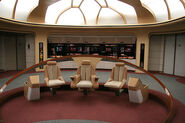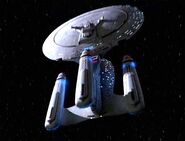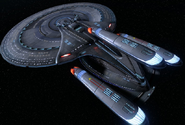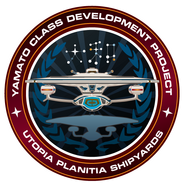- For additional meanings of "Galaxy class", please see Galaxy class (disambiguation).
The Galaxy-class was a type of starships in service to Starfleet in the mid to late 24th century.
History[]
Development[]
The Galaxy-class began development in 2343 and gained the dubious distinction of having the longest design, development, and construction period of any class in Starfleet up to that point. The prototype, USS Galaxy, launched in 2357 and its first two sister ships, the USS Enterprise-D and USS Yamato, followed six years later in 2363. Starfleet initially ordered a total of thirteen Galaxy-class vessels, however Starfleet Command decided that only seven would be completed, with only the frameworks for the other six built. These six frameworks were broken down and carried by cargo carriers to remote sites to be held in case a later period of emergency necessitated their completion.
Battle of Wolf 359[]
The emergency came in the form of the Borg at the Battle of Wolf 359 - 39 starships were destroyed. The incident propelled Starfleet into a massive ship design and building program where the additional six Galaxy frames were completed and many additional starships of the class were constructed to supplement the fleet. While the expected Borg invasion did not come as imminently as expected, the newly constructed Galaxy-class starships would prove useful in the Federation's war with the Dominion.
The Dominion War[]
In 2370, the Galaxy-class USS Odyssey became one of the first casualties of the Dominion's forces when it was rammed by a Jem'Hadar fighter. During the Dominion War, some Galaxy-class starships were refit to carry a compliment of 140 quantum torpedoes in addition to their standard 450 photon torpedoes. Afterwards, Galaxy-class ships went on to play a major part in numerous engagements in the war, including acting as the heavy-hitting core of multi-vessel formations dubbed Galaxy Wings.
Shortly before the war, three Galaxy-class starships, USS Abraham Lincoln, USS Citadel, and USS El Dorado, underwent experimental refits into as carriers for Peregrine-class fighters. The expanded hangar bay and increased crew capacity and machine shops required for this role were accommodated by a reduction in crew amenities, coupled with a fleetwide ban on officers' families being brought aboard, enacted after the loss of the Odyssey.
Postwar service[]
Having learned many lessons from the engineering failures of the first run of Galaxy-class starships that culminated in the destruction of the USS Enterprise-D, later models featured vastly improved safety systems, including improved ejection systems and manual circuit breakers for the holodecks. The Galaxy proved one of Starfleet's longest-running designs ever, with new hulls continuing to launch as late as 2409, aided by class' inclusion in the Modular Design Program.
Technical information[]
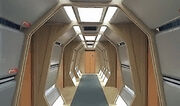
Typical corridor section on a 2360s Galaxy vessel.
Variants[]
Dreadnought[]
After the collapse of the Khitomer Accords in the Cryptic universe's 2399, some Galaxy-class vessels were refit into a dreadnought variant. The Galaxy starships had seen great success during the Dominion War and Starfleet Command thought a more combat focused variant could prove useful in future large-scale conflicts. In response to increasing hostility with the Klingons in the early 25th century, the Galaxy dreadnought variant carried a cloaking device and a devastating spinal lance weapon.
Subclasses[]
In the Cryptic universe, multiple subclasses of the Galaxy-class were developed as part of the Modular Design Program.
Celestial[]
The design of the Celestial-subclass was reminiscent of the Ambassador-class cruisers, as Starfleet engineers took the design aesthetic of the older Ambassador and applied them to the newer Galaxy-class. Distinguishing differences between the Celestial and Ambassador designs were the straight pylons, conical warp nacelles and engineering hull, and a thicker saucer.
Envoy[]
Longer than the standard Galaxy-class or the Celestial-subclass, the Envoy-subclass was also bulkier and had a larger saucer and neck. The starship's pylons were slightly banked and forked toward the nacelles. Its nacelles were less armored than the other types, with a field grille covering the ventral end of the nacelles.
Venture[]
The Venture-subclass was larger than even the Envoy-subclass. It had a longer, more swept neck and a more faceted main deflector. It also bore design details of the Sovereign-class, such as the raised V-shaped platform on the primary hull detail.
With the success of the dreadnought variant of the Galaxy-class, the Starfleet Corps of Engineers also designed a dreadnought variant of the Venture-subclass to serve as a more combat ready version of the exploration vessel.
Monarch[]
Though similar in layout to the standard Galaxy, the Monarch-subclass took on harder edges, banked nacelles, and other structural changes throughout the spaceframe, incorporating lessons learned from its older siblings' 50 years of service. It also tied with the Venture-subclass for the largest variant of the Galaxy line.
Andromeda[]
Following the success of the Pathfinder-subclass in Operation Delta Rising, designers at the Utopia Planitia Fleet Yards began work on updates of other core ship designs in the Federation fleet. The Andromeda-subclass was the first starship developed from this effort. The Andromeda incorporated updated technology developed to give the vessel improved capabilities for the difficult challenges Starfleet faced in the early years of the 25th century.
Yamato[]
The Yamato-subclass was a dreadnought upgrade to the Andromeda-subclass. While Starfleet engineers tailored the Andromeda to be a versatile class of explorer, the Yamato-subclass was intended to be the most advanced version of the Galaxy dreadnought variant to date.
Ships commissioned[]
- Main article: Category:Galaxy class starships
| Registry | Name | Status | Notes |
|---|---|---|---|
| NCC-71127 | USS Abraham Lincoln | Active | Refit as a carrier, 2373 |
| (unknown) | USS Agrippa | (unknown) | |
| (unknown) | USS Allegheny | (unknown) | |
| NCC-72402 | USS Asgard | (unknown) | Destroyed in Battle of Rashanar |
| NCC-97238 | USS Bajor | Active | |
| NCC-71099 | USS Challenger | Active | Under the command of Captain Geordi La Forge |
| NCC-75435 | USS Cheyenne | (unknown) | |
| NCC-71845 | USS Citadel | Active | Refitted as a carrier, 2373 |
| CRC-08 | USS Concord | (unknown) | |
| NCC-71879 | USS Dauntless | (unknown) | |
| NCC-71880 | USS El Dorado | Decommissioned | Refit as a carrier, 2373. Damaged beyond repair by Narada, 2387. |
| NCC-1701-D | USS Enterprise | Destroyed | Federation flagship. Destroyed at Veridian III in 2371. |
| NCC-93534 | USS Galar | Refit | Refit as a dreadnought cruiser |
| NCC-70637 | USS Galaxy | Active | First ship of its class |
| (unknown) | USS Hedderjin | Active | Assigned to patrol the Romulan Neutral Zone in 2380. |
| (unknown) | USS Idaho | (unknown) | |
| (unknown) | USS Madison | (unknown) | Took part in Battle of Sector 001 |
| NCC-71820 | USS Magellan | (unknown) | |
| NCC-72036 | USS Mukaikubo | (unknown) | |
| NCC-71832 | USS Odyssey | Destroyed | Rammed over Paradise by Jem'Hadar attack ship, 2370 |
| NCC-78566 | USS Olympus | (unknown) | |
| (unknown) | USS Oraidhe | (unknown) | |
| NCC-75698 | USS Oregon | Active | |
| NCC-71989 | USS Pavonis | (unknown) | |
| NCC-78562 | USS Pegasus | Active | |
| NCC-26965-A | USS Queen of the West | Active | |
| NCC-74780 | USS San Francisco | Active | Assigned to Starbase 12 |
| NCC-71847 | USS Trident | (unknown) | |
| NCC-71867 | USS Trinculo | (unknown) | |
| (unknown) | USS Ulysses | Destroyed | Destroyed at Starbase 24 during Borg invasion |
| NCC-71828 | USS Vanguard | (unknown) | |
| NCC-71854 | USS Venture | (unknown) | |
| NCC-71985 | USS Vesuvius | (unknown) | |
| (unknown) | USS Warspite | (unknown) | |
| NCC-71807 | USS Yamato | Destroyed | Core breach due to Iconian computer virus, 2365. |
| NCC-44278-A | USS Archer | Active | |
| NCC-7701-A | USS Endurance | Active |
Gallery[]
External links[]
- Galaxy class article at Memory Alpha, the canon Star Trek wiki.
- Galaxy class article at Memory Beta, the non-canon Star Trek wiki.
- Galaxy class article at Star Trek Expanded Universe.
- Exploration Cruiser article at The Star Trek Online Wiki.
- Exploration Cruiser Refit article at The Star Trek Online Wiki.
- Exploration Cruiser (T6) article at The Star Trek Online Wiki.
- Dreadnought Cruiser article at The Star Trek Online Wiki.
- Dreadnought Cruiser (T6) article at The Star Trek Online Wiki.


